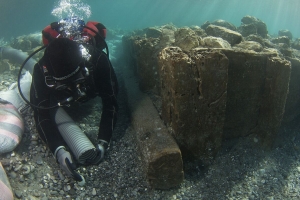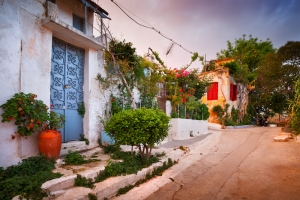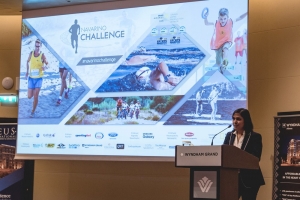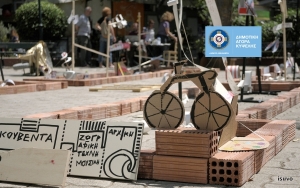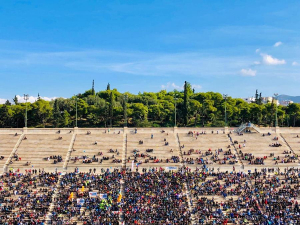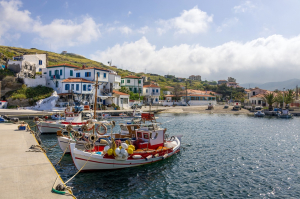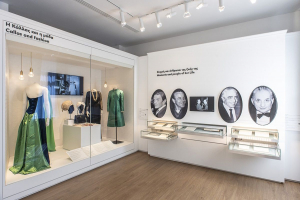BUSINESS CENTRE
XpatAthens
Thursday, 14 January 2016 07:00
Greek And Danish Archeological Team Investigate Important Harbour Town
In Greece, underwater excavations of Lechaion, ancient Corinth’s partially submerged harbour town, reveal the infrastructure of more than a thousand years of flourishing maritime trade. Researchers from the Greek Ministry of Culture and Sports and the University of Copenhagen are using cutting-edge methods to uncover the configuration and scale of the harbour.
Corinth ranked among the most economically and militarily powerful, and enduring, cities of the Greek, Roman and Byzantine periods. The city had an exceptional geographical advantage in the North East corner of the Peloponnese and controlled the Isthmus that facilitated land travel between Northern and Southern Greece, and travel by sea between the Western and Eastern Mediterranean.
Corinth, which lay some three kilometres from the sea, built on this natural advantage by constructing two harbour towns – the main harbour Lechaion on the Corinthian Gulf to the West, and Kenchreai on the Saronic Gulf to the East (see map to the right).
"According to ancient sources, most of the city's wealth derived from the maritime trade that passed through her two harbours, eventually earning her the nickname ‘Wealthy Corinth’," says archeaologist Bjørn Lovén from the University of Copenhagen and co-director of the Lechaion Harbour Project (LHP).
The moles and warehouses of Lechaion saw vibrant maritime activity for over a thousand years, from the 6th century BC to the 6th century AD. Ships and fleets departed from here laden with cargoes, colonists and marines destined for ports all over the Mediterranean and beyond.
To read more, please visit: Humanities DK
Published in
Greece In The News
Tagged under
Thursday, 13 October 2016 07:00
Greek Olive Oils Used For Medical Research
Greece has over a thousand extra virgin olive oils tested by NMR that meet and exceed the EU criteria for health-promoting phenolic compounds. On the rising tide of astonishing research into the health benefits of olive oil in the daily diet, Greek EVOOs are riding this wave of change in the olive oil industry.
In these three studies reviewed, they look to Greek High Phenolic Extra Virgin Olive Oil, proving the ancient wisdom of food as medicine.
In 2012 the EU approved a health claim labelling regulation which created the new category of High Phenolic EVOO. It stated that olive oils containing a specified amount of polyphenols (phenolic compounds) could put a health claim on the label as it was well researched and documented that High Phenolic olive oil has a beneficial effect on the blood lipid level. In simple terms it is good for the heart.
In the same year, Dr. Prokopios Magiatis at the University of Athens discovered an accurate way to identify and measure the polyphenols in olive oil using sophisticated Nuclear Magnetic Resonance (NMR). His interest was primarily in oleocanthal, the phenolic compound found only in olive oil. Oleocanthal was pulling out front in research for its broad reaching affect on chronic disease like Alzheimer’s, Parkinson’s, heart attack and stroke, rheumatoid arthritis, Type II diabetes and even cancer. Its effectiveness was proving itself in the prevention, treatment and sometimes reversal of symptoms. Tests on over two and a half thousand olive oils has revealed best harvest and production practices for optimum concentration of phenolic compounds.
In the four short years since 2012, testing of olive oils from countries around the globe have revealed that early harvest green olives do indeed yield the highest levels of phenolic compounds and that olive oils high in healthful phenolic compounds stay fresh and vital longer.
The movement amongst olive growers throughout Greece is nothing short of a revival of the ancient Hellenic standard of excellence in olive oil. The wave is surging into the other olive oil producing countries as testing and research exemplifies the health-protective benefits of High Phenolic EVOO and practices and methods of production are refined.
Three companies – a distributor, a family business and an importer are being the change they want to see. Greece is once again reaching out into the world. These three companies not only provide excellent products, are invested in sustainable technology and innovation, but they are each involved in research and consumer awareness for this new category of tested and certified health-promoting High Phenolic EVOO.
To read this article in full, please visit: Huffington Post
Published in
Greece In The News
Tagged under
Wednesday, 07 December 2016 02:55
December 6 - Local Cuisine And Culture
Explore the museum without a home in Athens, discover a new restaurant, and learn how to make traditional Greek custard pie!
Please click HERE to view this issue of our newsletter!
Published in
Newsletters
Tagged under
Wednesday, 28 June 2017 11:23
Giannis & Thanasis Antetokounmpo Join Forces With The Onassis Foundation - An Extraordinary Collaboration
Inspired by the career and the ethos of the Antetokounmpo brothers, the Onassis Foundation establishes "One of a Kind", a new undergraduate scholarship for young people who were born in Greece but have still to secure Greek nationality or have received it within the last five years.
On Saturday, June 24th, 2017 before a packed house at the Onassis Cultural Centre (OCC), Giannis and Thanasis Antetokounmpo discussed with Afroditi Panagiotakou, Director of Culture at the Onassis Foundation. As announced right from the start, their talk, which has already received over 100,000 views on the OCC's Facebook page, was less about basketball and more about the importance of the journey, about what being 'Greek' actually means, and about the virtues that can help you reach the top. This extraordinary collaboration between the Antetokounmpo Brothers and the Onassis Foundation culminated in the announcement made by Afroditi Panagiotakou as the event neared its end: the establishment of the "One of a Kind" undergraduate scholarship for young people who, though born in Greece, have yet to secure Greek nationality or have received it within the past five years.
In recognition of the Antetokounmpo brothers' contributions to sport and of their successful careers, and in the light of their social starting point, the Onassis Foundation announced that it would be sponsoring a Special Scholarship for undergraduate studies in the Greek Higher Education sector.
Since 1978, the Onassis Foundation has granted 7000 scholarships to students and academics both Greek and non-Greek. The Foundation's Scholarships Programme approves over 200 scholarships per year, some of which go to Greek students undertaking doctoral and post-graduate studies in Greece and abroad, and some to academics from abroad to help them undertake postgraduate studies and research in Greece. The special "One of a Kind" undergraduate scholarship, and the collaboration with Giannis and Thanasis Antetokounmpo, seek to send out a symbolic message: we need to try and change the way we think. Because you do not have to be born Greek—you can become Greek, too.
It wasn't just the Antetokounmpo brothers' success that inspired this collaboration, but also the qualities the two Greek athletes embody: modesty, competitiveness, passion, hard work and an intention to help those who, despite their desire to get ahead in life, find themselves held back by social and economic exclusion.
Highlights from the discussion between Giannis and Thanasis Antetokounmpo and Afroditi Panagiotakou:
Why do they think people are so fond of them?
Giannis Antetokounmpo: Greece loves us because we're good kids, virtuous kids. Wherever we go, Greece comes with us. We promote Greece a lot, and fame hasn't changed us. We're still who we used to be, because we have exceptional parents who raised us right.
Their Vision
Thanasis Antetokounmpo: We are here to help each other. We know times are hard for all of us, but that's the way to survive hard times: by supporting one another.
Giannis Antetokounmpo: We came to talk to you, the Onassis Foundation, because we wanted to learn. You have helped so many people, so many children, and I want, one day many years from now, to be able to do the same.
What do 'getting ahead' and having faith in yourself mean for Giannis Antetokounmpo
If you want to get ahead, hard work is the key. And now that we're making it, that we're getting ahead, it's even harder to stay there. It takes even more hard work. People say to us "You've reached the top, you've made it", but I haven't accomplished anything. My goal is to be a champion, an MVP (Most Valuable Player), to be one of the fifty best players ever to play basketball. The work is the crucial thing, you have to keep pushing yourself to your limits. Don't think of yourself as average--you're not average and don't ever let that thought into your head. If you think you're average, that's exactly what you'll be: average. And that will be the end of it. Right now, I think—and I'm not bragging here, I'm not being arrogant - that I am the best player of all time and I know that's what I'll be. Work, work, work.
The flip side of success—Commenting on a verse in Giannis' Instagram profile: "It's beauty in the struggle, ugliness in the success"
Giannis Antetokounmpo: You've got to love what you've got. I remember us, myself and my family, having a good time even when times were hard. I saw them every day, we spent all day together, laughing. Now that I'm successful, it's hard to get together. I travel such a lot, it's really hard to meet up so often. So there's 'ugliness' even in success.
How do you deal with the 'dark moments'?
Thanasis Antetokounmpo: Everyone has difficulties to face up to. When they tell me “You had it hard”, I always say a lot of people do. Because me not having enough to eat doesn't mean you don’t have problems of your own too. You might not have been able to pay for extra tuition for your kids, you could have lost your job. It's something different for everyone. But you need to seek out the light in the darkness.
The song their mother sang to wake them up for school—the moment that brought tears to the Antetokounmpo brothers' eyes.
The auditorium was awash with emotion when the Greek song The rooster (When, my mistress, I go to the market) was heard — the song the boys' mother, Veronica Antetokounmpo, used to sing to wake her children up every morning. With tears in his eyes, Giannis Antetokounmpo said: "I didn't cry when we lost in the play offs... We started out when we were little and now we're here. Who would ever have believed it? That me, Thanasis and my family, joining forces with you, could ever provide other children with opportunities!"
On the racism they've encountered
Thanasis Antetokounmpo: There's no racism in Greece, just hypocrisy. Which is worse. In America, there is racism, but you can be anything you set out to be in your life. Here, there's hypocrisy and that's worse. I've seen negative posts on Facebook about us, posts saying we're not Greek, and then met the same person who posted it in Glyfada with his kid, only for him to congratulate me and tell me I'm a credit to Greece. I lifted his kid up onto my shoulders for a photograph and I thanked him.
Giannis Antetokounmpo: There's the bad side and there's the positive side. We had friends who defended us. When someone said something bad, they’d answer back and stop hanging round with them.
On being Greek
Giannis Antetokounmpo: You don’t have to be born Greek. you can become Greek, too. No one can tell me I'm not Greek. The only thing we can do with people who believe that is love Greece more than they do.
On nationality
Thanasis Antetokounmpo: I was without a Greek passport for two and a half years. I played friendlies with the Greek National youth, teenage and children's teams and our opponents would ask why I never took part in tournaments, and the reason was I didn't have a Greek passport. And there are a lot of kids like us. Kids who could offer a lot to the country, but who are prevented by the nationality issue. And it shouldn't be like that. When you go to primary school, high school and senior high in a country, you should automatically be given citizenship. You shouldn't have to be the Antetokounmpo brothers to get it.
If you could turn the clock back, what would you say to your 10-year-old self?
Giannis Antetokounmpo: If I could go back, I'd tell myself to be patient and to keep on working at it. There were days when I felt dissapointed. But I never stopped believing that I'd make it in the end and be able to help my family. I'd tell myself: "Be patient, keep on smiling, and everything will come to you". If you keep on working hard and believe in your dreams, you can be sure you will get ahead, certain you'll keep on getting better.
Thanasis Antetokounmpo: If I went back, the first thing I'd say would be "Don't cry. Don't feel sad". I grew up feeling sad. People are forever asking why I smile all the time. Well, it's because I grew up feeling upset and sad. I saw my parents struggling, I saw my brothers and sisters, and when you're the eldest, you want to help.
Press Release by the Onassis Foundation
To watch the full discussion (in Greek), please visit: Onassis Foundation
Press Release by the Onassis Foundation
To watch the full discussion (in Greek), please visit: Onassis Foundation
Published in
People
Tagged under
Monday, 02 October 2017 11:00
Navarino Challenge 2017
The top sports tourism fest is fast approaching on October 13-15.
The official presentation of “Navarino Challenge” took place on September 27th – World Tourism Day, announcing the event’s highlights. The 5th annual sports tourism fest will take place on October 13- 15 2017, in Messinia and Costa Navarino.
The press conference was hosted at the Wyndham Grand Athens hotel, and was attended by distinguished guests, including among others, the Greek American ultramarathon runner Dean Karnazes, who participates at the event as its ambassador in Greece and abroad for the 5th consecutive time, the Olympic and World Champion in 400m. hurdles, Periklis Iakovakis and the physical education instructor specialized in pilates, Mandy Persaki. One of the day’s highlights was the exclusive presentation of the “Navarino Challenge 2016” video.
On behalf of Costa Navarino, Marina Papatsoni, Marketing & Business Development Director at TEMES, mentioned: “When we conceived the idea of Navarino Challenge in 2011, we didn’t think that we have achieved as much as we have today. It is one of those cases where we succeeded in doing much more than we would have dreamed of! Navarino Challenge is a great celebration, where athletes and organizers come together, have a good time, learn to love nature, sports, good nutrition, and eventually learn how to live better. We look forward to seeing you all in Costa Navarino to share once again, unique moments and experiences”.
Akis Tsolis, Chief Executive Officer of Active Media Group, said: “As the United Nations General Assembly affirmed when announcing 2017 as the International Year of Sustainable Tourism for Development, tourism can contribute to all the three dimensions of sustainable development – economic, social and environmental – and each of the 17 Sustainable Development Goals. All these goals have brought Navarino Challenge at the top of Sports Tourism Events. With principles based on the Olympic ideal and "fair play", from the first year in 2013 the event generated innovation and had a key role among sports tourism events. Once you participate in Navarino Challenge you will understand the essence of the famous Greek hospitality. The athletes that participate all comment how friendly and inviting the Messinians are. We owe huge gratitude to the people of the region and Costa Navarino for all they have done to make Navarino Challenge a success. We want the next generation of Greeks to feel and act differently about exercise, the environment and personal responsibility. We want to be part of creating a better Greece”.
On the official airline partner side, Theresa Cissell, Country Manager for Greece & Cyprus, of Qatar Airways, mentioned: “Qatar Airways, the national carrier of the State of Qatar, is celebrating 20 years of Going Places Together with travelers across its more than 150 business and leisure destinations. Qatar Airways is named “Airline of the Year” for 2017. Qatar Airways proudly supports a range of exciting international and local initiatives dedicated to enriching the global community that it serves. Qatar Airways, the official FIFA partner, is the official sponsor of many top-level sporting events, including Navarino Challenge, reflecting the values of sports as a key element in bringing people together. Navarino Challenge is a unique event that aims to raise awareness about the benefits of healthy living and exercise as well as the issue of childhood obesity, and through its numerous activities promotes the spirit of sportsmanship and fair play. Qatar Airways sponsorship strategy is aligned with the Qatar Vision 2030 and is based on three core pillars of Sports, Culture and Education, and for 3 consecutive years we are proud to fulfil our vision through Navarino Challenge and its ambassadors”.
On behalf of Sportingbet, Giannis Kapodistrias, stated: “In the last few years we watched Navarino Challenge as spectators with great admiration. It is such a pleasure for us that this year we sponsor this event. Of course, we will actively participate with our team in most sports. We are also looking forward to offering a warm welcome and a happy start to the full-of-surprises party that we organize at Costa Navarino for all participants on Friday night. We wish every success to Navarino Challenge 2017”.
On the side of the natural mineral water sponsor “Vikos”, Natassa Krentz, Marketing & Communications Manager of VIKOS SA, said: “VIKOS SA has lived for many years constantly next to sports, supporting the top sporting events organized in all lengths and widths of the country. We embrace and support events that include the values and athletic ideal that characterizes our company and governs our strategy. We promote in a multidimensional way the athletic activity and the spirit of good sportsmanship, in high level events with great appeal and infiltration to the general public, in all ages, ordinary citizens and athletes, supporting local sports clubs and a number of sporting events and activities throughout Greece. In this spirit the active support of Vikos is included in another Navarino Challenge for the 5th consecutive year, the top event of sports tourism in Greece, taking place in the enchanting and rich in history landscape of Messinia, at Costa Navarino. The Natural Mineral Water “Vikos”, the first bottled water in Greece, will provide the necessary hydration and stimulation to athletes of all ages and activities thanks to its rich mineral composition. Natural Mineral Water “Vikos” is bottled directly in the homonymous source, in the pristine and protected Zagorohoria, and has been recognized as Natural Mineral Water suitable for low-sodium diet, low salt and high in calcium, contributing to the good functioning of the organism. “Vikos” natural mineral refreshments will cool young and older people with their 8 unique flavors, while they are the only ones with Natural Mineral Water and natural fruit juices”.
Petri Logara, Ford Motor Hellas Operations Manager, also commented: “Ford Motor Hellas has the pleasure of participating for the fourth consecutive year, as a transportation sponsor, in one of the most important sporting and tourism events of our country, which promotes “fair play”, Navarino Challenge! In one of the most beautiful places in Greece, in the picturesque Messinia, young and older people will have the opportunity to experience the joy and well-being of sports through many different activities as well as to relax and rest at Costa Navarino. Ambassadors in their efforts will be the Greek American ultramarathon Dean Karnazes and the Olympic medalist of Tae Kwon Do Alexandros Nikolaidis. We wish a great success to the event and fun for everyone!”
The Greek-American ultramarathon Dean Karnazes stated, among other things: “Five years ago Peter Poulos and Akis Tsolis came to me with an idea. So they asked me ‘what do you think’ and I told them it is a good idea but it is a very progressive idea. You are ahead of your time. Last month Sir Richard Branson came to me and he said I have an idea for an event. He said “I want it to be for athletes of all ages & abilities. I want to offer more than just running”. So he said “What do you think?” and I said “You are 5 years too late!”. What is happening here, I think is fantastic, and I say that having run in many such events in various places around the world, I am proud to be an ambassador to this particular event”.
The new schedule of the multi-awarded event includes 17 activities, and registrations for “Navarino Challenge” in running, swimming and SUP continue for a few more days. For your registration please complete the form HERE!
Kinder + SPORT, Ferrero’s Corporate Social Responsibility Program, will be supporting this year's “Navarino Challenge” as part of the effort to boost physical activity in young children. In particular, as an official promoter of the Navarino Challenge, it embraces the Kids’ Athletics by Kinder + SPORT activity, bringing the children into contact with the track and field events, with Ambassador the Olympic and World Champion at 400m. hurdles, Periklis Iakovakis. In addition, the range of activities for children includes Tae Kwon Dowhereby through the “voice” of the Olympic medalist Alexandros Nikolaidis, Kinder + SPORT will encourage children to have fun through sports and to engage in an active lifestyle, finding and practicing the sport they love.
The official airline partner of the event, Qatar Airways, continues to attract visitors from more than 150 destinations worldwide, offering discount up to 25% off their return tickets for the “Navarino Challenge”: http://www.qatarairways.com/gr/el/cugs/navarinochallenge.page
Sportingbet, one of the leading online gaming companies in the world, is participating this year as an official sponsor, while Samsung as an official technology partner.
Athletes taking part will have the opportunity to quench their thirst with the natural mineral water “Vikos” that contributes to the good body’s good function during sports. At the same time for the fourth consecutive year, athletes and organizers will move with the safety and efficient engines of Ford Motor Hellas, the official sponsor of Navarino Challenge.
National Geographic part of FOX Networks Group Greece is a strategic partner of the event for one more year, while with its numerous team it will have a dynamic presence in all sports activities!
Melissa pasta will be the official nutrition supporter for the first time. Melissa will be in Messinia and Costa Navarino on the occasion of Navarino Challenge with its new food truck, “Melissa On the road” and favorite food blogger Mamatsita will treat all participants in the Melissa Pasta Party, where she will create special autumn recipes with Melissa whole wheat penne, farfalle and fusilli. Because in sports we are also fans of pasta!
Official supporters include BIC®, BIC® Sport, GoPro, Wyndham Grand Athens, Poseidonia, Surf Salad and the sports nutrition company QNT
Navarino Challenge” will be held under the Auspices of the Greek National Tourism Organization with the co-organization of Costa Navarino, The Westin Resort Costa Navarino and Active Media Group and the support of the Municipalities of Pylos-Nestor and Trifilia. The sport of boccia will be held under the auspices of the Hellenic Paralympic Committee.
Official Airline Partner: Qatar Airways
Official Technology Partner: Samsung
Official Sponsors: Sportingbet, Natural Mineral Water “Vikos”, Ford Motor Hellas
Official Nutrition Supporter: Melissa
Official Supporters: Kinder + SPORT, BIC®, BIC® Sport, GoPro, Wyndham Grand Athens, Poseidonia, Surf Salad, QNT
Strategic Partner: National Geographic
Assisted by: Inbi, Navarino Outdoors, Swim Academy, Navarino Racquet Academy, Health Runners Club of Messinia, Pylos Association of Enterprises for Tourism Development, Maritime Athletic Pylos Association “Nestor”, Explore Messinia, Navarino Golf Academy, Hellenic Athletics Federation (SEGAS), IAAF Kids Athletics, Vizantinos target sport club, Target Security
Published in
Local News
Tagged under
Tuesday, 19 June 2018 00:23
The First Social Entrepreneurship Market In Greece
A brand new, non-profit project from Athens Municipality and Impact Hub Athens has begun in the market of Kypseli.
Focusing around people, the environment and a sustainable growth strategy, 8 organisations will be the first stores to set up shop.
The Kypseli Market will include products from local farms, some of which will be given to people in need.
Included at Kypseli Market is a flowershop, which offers opportunities, skills and work to people with disabilities, a store selling second hand products in order to assist people with psychological problems find a job, and many others who will help raise money for the environment and people in need.
The market will become a point of connection between locals in this historic and multicultural area and will promote a collaborative and creative spirit!
See you at the Kypseli Municipal Market on Fokionos Street!
Published in
Local News
Tagged under
Tuesday, 13 November 2018 20:50
November 13th - We Love Athens!
Athens once again proves how modern and vibrant it is. From winning the ''European Capital of Innovation'' award to succesfully hosting the 36th Athens Authentic Marathon for another year. What a week this has been for our city!
Please click HERE to view this issue of our newsletter!
Published in
Newsletters
Tagged under
Monday, 10 January 2022 07:00
Greece Ranks 5th As Vegetarian Destination In Europe
Despite just 2% of the country’s population being vegetarian, Athens has the fifth highest-rated vegetarian restaurants in Europe, with an average rating of 8.74/10 – a score higher than other “food capitals” such as Rome (8.41/10) – according to experts at Uswitch.com.
On the occasion of Veganuray 2022, they wanted to find the best European capital cities for vegetarians to live in.
By analyzing the average ratings of vegetarian restaurants across each European capital, they found Belgrade to rank at the top with a score of 8.85/10. Valetta, Zagreb, and Tirana made up the rest of the top five.
Originally published on: ekathimerini.com
On the occasion of Veganuray 2022, they wanted to find the best European capital cities for vegetarians to live in.
By analyzing the average ratings of vegetarian restaurants across each European capital, they found Belgrade to rank at the top with a score of 8.85/10. Valetta, Zagreb, and Tirana made up the rest of the top five.
Originally published on: ekathimerini.com
Published in
Greece In The News
Tagged under
Monday, 14 November 2022 07:00
Ai Stratis To Become The First Completely Green Island In Greece
The creation of the first completely 'green' Greek island has entered the final stretch. The small island of Ai Stratis, with just over 200 inhabitants, is expected to become the first island in Greece to be powered exclusively by electric and thermal energy from renewables, ANA reports.
The small hybrid project in progress on Ai Stratis, a remote Greek island of the northern Aegean, will act as a guide for larger projects.
The plan calls for the small Public Power Corporation (PPC) power plant on the island, which runs on expensive diesel, to fully shut down its operation and for the island to make a transition to full energy autonomy.
The Environment and Energy Ministry granted a unified license to the municipality of Ai Stratis to install a hybrid power plant for the production of electricity using wind and solar and for the storage of electricity with the use of accumulators.
Originally published on: tornosnews.gr
The small hybrid project in progress on Ai Stratis, a remote Greek island of the northern Aegean, will act as a guide for larger projects.
The plan calls for the small Public Power Corporation (PPC) power plant on the island, which runs on expensive diesel, to fully shut down its operation and for the island to make a transition to full energy autonomy.
The Environment and Energy Ministry granted a unified license to the municipality of Ai Stratis to install a hybrid power plant for the production of electricity using wind and solar and for the storage of electricity with the use of accumulators.
Originally published on: tornosnews.gr
Published in
Local Environment
Tagged under
Sunday, 29 October 2023 13:12
World’s First Maria Callas Museum Opens its Doors in Athens
The world’s first museum dedicated to the legendary Greek soprano Maria Callas has opened its doors in Athens, coinciding with the 100th anniversary of her birth.
The Maria Callas Museum, located at 44 Mitropoleos Street, a three-story neoclassical building in the center of Athens, will house a permanent collection of over 1,000 objects that belonged to or are related to the legendary opera singer.
Visitors can expect to see rare photographs and portraits, records, and personal items, such as her stage costumes and jewelry. They can also listen to live recordings or watch other related audiovisual material.
The museum’s exhibits will shed light on Callas’ career and personality, beyond the myths that have circulated about her. The goal of the museum is to inspire, entertain, and highlight the elements of her technique that made her unique.
To read this article in full, please visit news.gtp.gr
To read this article in full, please visit news.gtp.gr
Published in
Local News
Tagged under


